This gumbo recipe is a soul-satisfying taste of New Orleans, loaded with juicy chicken, smoky Andouille sausage, plump shrimp and bold spices – it’s one for the recipe binder!
This chicken sausage gumbo is one of the most flavorful, satisfying meals you’ll ever devour; the kind of hot, steaming spoonful that makes your eyes roll back in your head in awe. So, if you’ve never made this New Orleans classic before, NOW is the time – it’s easier and 1000x better than you might think! This recipe boasts a deeply flavorful, dark chocolate colored roux, the holy trinity of onions, bell peppers and celery, protein in the form of juicy chicken, andouille sausage and optional shrimp, all boldly seasoned with a homemade paprika, cayenne, thyme spice mix for zippy, smoky, nutty heat. Serve your chicken gumbo over a big bowl of rice for one of life’s most dizzying delicious pleasures.
Stew recipes are comfort food to the max like this Chicken Gumbo, Crockpot Beef Stew, Chicken Stew, African Peanut Stew, Hungarian Goulash and Chile Colorado.
PIN THIS RECIPE TO SAVE FOR LATER
How to Make Gumbo Video
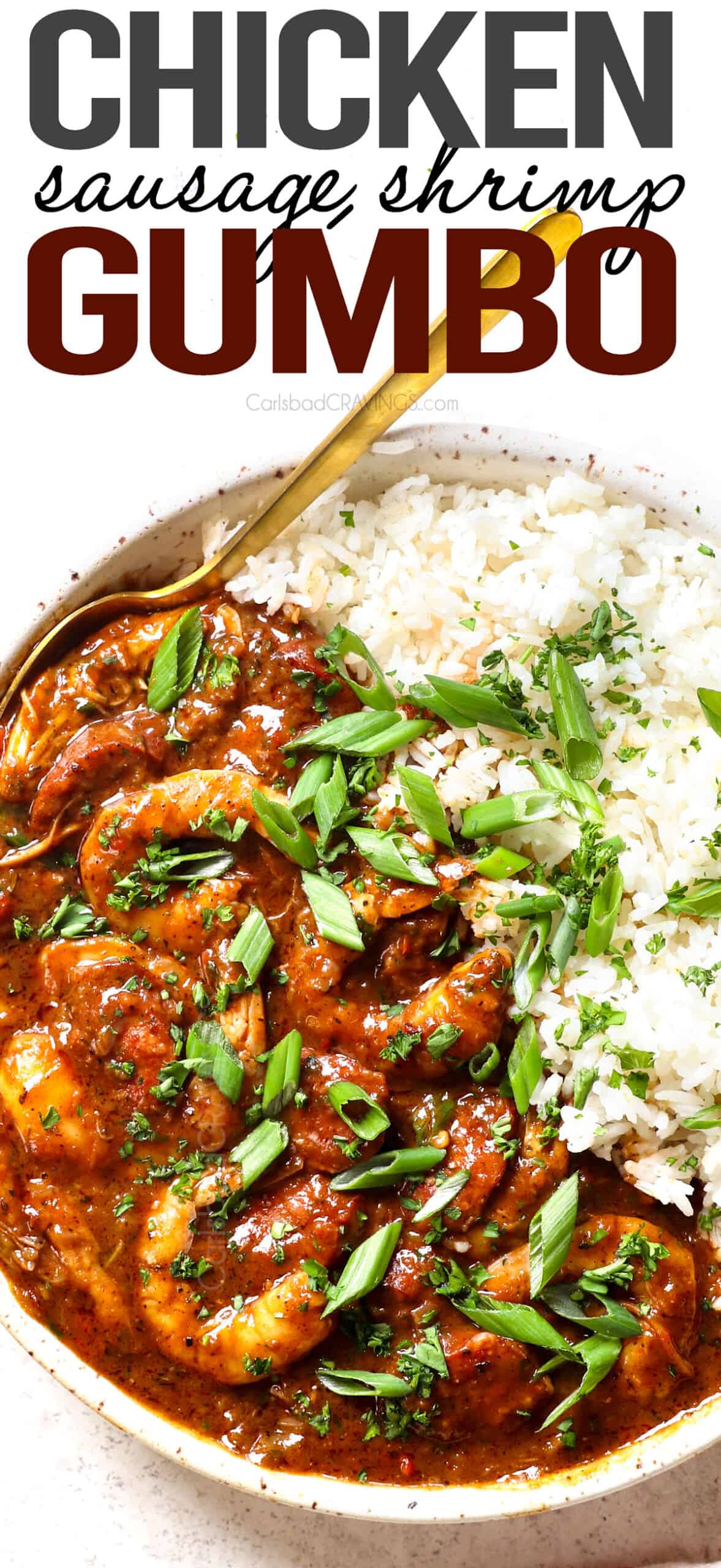

What is gumbo?
Gumbo is a thick, hearty stew that’s a the official dish and cultural symbol of Louisiana, and a prime example of Creole cookery which blends West African, French, Spanish, and Amerindian influences.
Gumbo is made from meat (such as andouille sausage, chicken and/or ham), and/or shellfish (shrimp, crab, oysters, etc.), a thickener (roux and either okra or filé powder) and the Creole and Cajun “holy trinity” ― celery, bell peppers, and onions. Gumbo is traditionally served over white rice, making it an extra satisfying meal!
There are many variations of gumbo, largely depending on if it’s Creole Gumbo or Cajun Gumbo. Creole Gumbo generally starts with a dark roux and contains shellfish and often tomatoes to compliment the seafood. Cajun Gumbo is generally thickened with a roux and contains meat, (andouille sausage and chicken being the most popular combination) and skips the tomatoes.
Today, I’m sharing a gumbo recipe made with chicken, andouille sausage and optional shrimp, thickened by a roux and filé. See below why I think it’s the best!

WHY this gumbo recipe works
Luxuriously thick. This chicken and sausage gumbo is the consistency of a thick and hearty stew, like traditional gumbo should be, not sad and watery. Of course, if you prefer a more soupy consistency, you can easily thin it out with more broth.
The most flavorful roux. This recipe begins by searing chicken thighs, followed by andouille sausage, in the same pot, which leave behind deeply golden bits of dynamite flavor that become part of the roux. The roux is then cooked to the color of dark chocolate for a depth of flavor you’ll have to taste to believe.
Quicker roux. Due to browning the chicken and sausage before adding the flour, the roux darkens much more quickly than other recipes, in 20 minutes or less, so you don’t have to worry about whisking for 40 minutes!
Shortcut holy trinity. The onions, bell peppers and celery are chopped in the food processor in minutes so there is practically zero chopping in this gumbo recipe, other than chopping the veggies to fit the processor.
Adeptly seasoned. Instead of relying on store-bought seasoning mixes which can vary from one to the other, this recipe uses a homemade blend for the perfect punch of flavor.
Make it spicy or not. By making our own seasoning blend, you can easily make this shrimp gumbo as spicy or as mild as you like by adding more or less cayenne pepper.
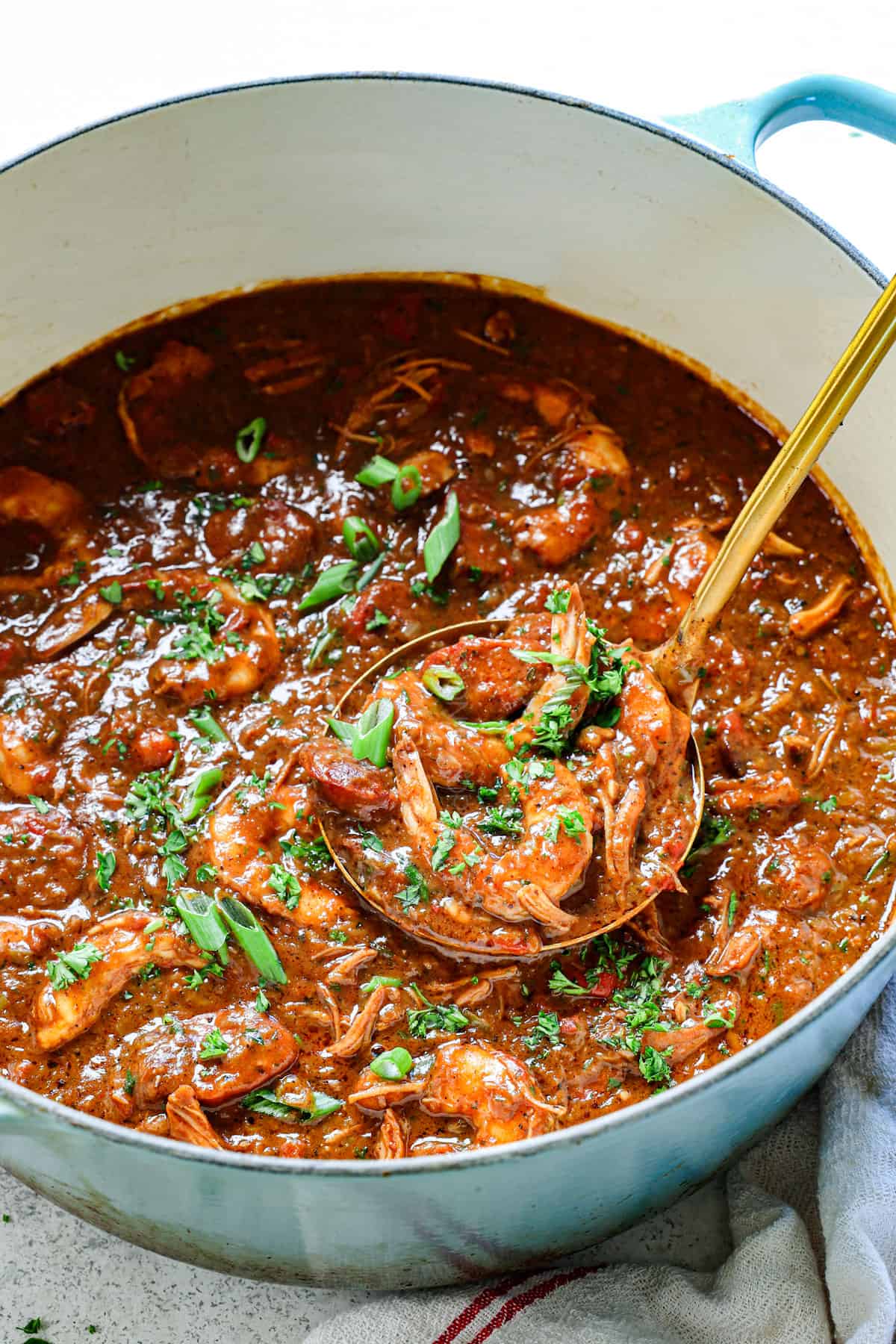
Gumbo FAQs
The word “gumbo” comes from the West African word “ki ngombo” for “okra.” West Africans used okra as a thickener in their dish which they brought to America.
Most historians agree gumbo has its origins in West Africa and draws inspiration from Native American, African, and European cultures. West Africans brought okra pods to the Americas during the transatlantic slavery period. They planted and harvested the okra seeds and introduced the dish to the Americas.
Over the years, gumbo was further influenced by Native American and European American settlers. Choctaws contributed filé gumbo powder to thicken and flavor the dish. Roux was later introduced as a thickener instead of file or okra, which has its origins in French cuisine.
Gumbo can be made with virtually any protein (chicken, sausage, ham, etc.) and/or seafood (shrimp, oysters, crab, etc.), so its distinguishing factors are: 1) the thickening agent, typically a roux and either okra or gumbo filé; 2) The “holy trinity” – a combination of bell peppers, onions and celery which is the base of much of Creole and Cajun cooking. Other important ingredients include a flavorful broth (typically chicken or seafood) and seasonings such as paprika, cayenne pepper, and thyme.
Generally speaking, Creole gumbo often includes tomatoes, while Cajun gumbo does not. Creole gumbo is typically made with shellfish and the acidity of the tomatoes complements the seafood. Cajun gumbo is commonly made with chicken and sausage and most Cajun cooks will tell you it’s a sin to add tomatoes to gumbo!
Despite the many variances in shrimp, chicken and sausage gumbo recipes, they all follow the same basic technique: brown the meats, sauté the aromatics, make the roux, add the stock and seasonings and simmer until the meats are tender and the gumbo is thickened. Lastly, add quick-cooking proteins, like shrimp and oysters, and add the gumbo file off heat.
Gumbo is traditionally thickened with a roux, a French and Creole method of cooking equal parts flour and fat, then either filé or okra, but never all three or your gumbo will be too thick. Here’s the breakdown:
1. Roux: This is made by cooking flour in oil until a dark chocolate color. The darker the roux, the more flavorful it will be.
2. Okra: This is the original thickening agent in gumbo which also adds a distinct flavor. Some people love it, some people hate it! Today, chopped fresh or frozen (thawed) okra is most popular in seafood gumbos.
3. Gumbo Filé: Like okra, this is both a thickening agent and a flavoring agent. It’s become a popular alternative to okra made of dried and ground sassafras leaves, a plant native to north east America. The powder is added at the end of the cooking process off heat, or at the table, otherwise the gumbo can become stringy.
First let’s clear up Cajun vs. Creole. Cajun and Creole are two distinct ethnic groups with their own unique history, traditions and culture. Creole cooking existed far before Cajun cooking. It describes the French and Spanish influences found in Louisiana in the 1700s when New Orleans was founded by the French, followed by Spanish control in 1769. (Louisiana was not sold to the United States until 1803.) It later grew to include Acadian, Caribbean, West African, German and Native American influences.
Cajun cooking, on the other hand, made its way to Louisiana in the late 1700s when Acadians relocated there. Acadians are French colonist who, in the early 1600s, settled the Acadia region, (today known as Nova Scotia, New Brunswick and Prince Edward Island). As a result of the French and Indian War, the British expelled the Acadians from their homeland and many migrated to Louisiana, with the belief that France still had control of the region. However, by the time they arrived in Louisiana in 1765, the colony had become the property of Spain.
Cajun and Creole gumbo are very similar. They both begin with a roux, include okra or filé powder, the holy trinity and similar seasonings. Cajun gumbo, however, usually includes chicken or sausage, and never tomatoes. Creole gumbo, however, is usually shellfish based and often includes ham or sausage, but not chicken. Creole gumbo also usually includes tomatoes to compliment the seafood.
Gumbo is a rich, flavorful stew with a nutty, earthy, paprika forward flavor profile. It is heavily influenced by the ingredients used. For example, okra (if using), lends a bitter sweetness with a slimy texture. Gumbo file powder, on the other hand, lends a cross between root beer and thyme. The holy trinity of onions, bell peppers and celery adds an aromatic sweetness. The popular inclusion of andouille sausage adds juicy pops of spiciness, whereas shrimp is buttery and mild.
Gumbo is a hearty stew made with a dark roux, the holy trinity of onions, bell peppers and celery. To be a true gumbo, it must have either okra or gumbo file.
All gumbo recipes require a few steps and simmering time, but are not difficult to make. This recipe eliminates the chopping by using a food processor, then the most difficult part is patiently waiting while the roux develops into a deep chocolate color. The rest of the recipe searing and simmering!
Gumbo can be made with a mixture of any proteins such as chicken, andouille sausage, shrimp, crab, and/or oysters.
Yes! The shrimp in this recipe is optional, although I love the texture and flavor it adds. If you omit the shrimp, you’ll want to increase both the chicken and sausage.
The Holy Trinity is a classic flavor base in both Creole and Cajun cooking made of diced onions, bell peppers and celery. They are cooked in butter or oil to release their flavor which forms the base of stews, soups, sauces, etc.
The best type of oil for gumbo is a neutral, high smoke point oil such as vegetable oil, canola oil, sunflower oil or peanut oil. Do not use olive oil because it has a low smoke point and too strong of a flavor. Also, don’t use butter because it creates a light flavored roux and is not recommended for the dark roux needed for the most flavorful chicken or seafood gumbo.
Gumbo should be thick like a stew, much thicker than a traditional soup. It is typically thickened with roux and either okra, or filé powder.
This gumbo recipe is thickened by a roux, file powder, and by simmering the stew for a time uncovered. If you simmer it covered for the whole time or add too much liquid, it will still be thin instead of thick. The quickest way to thicken a thin gumbo is to make a slurry by whisking 2 tablespoons cornstarch with ¼ cup water to make a slurry, then slowly stirring it into the stew, then simmering until it reaches your desired consistency.

gumbo vs jambalaya
Gumbo and Jambalaya are culinary treasures of Cajun and Creole cooking. Both include the holy trinity of onions, bell peppers and celery, Cajun seasoning and meats like shrimp, chicken and sausage, however, they are very different dishes.
Gumbo is a rich, hearty stew made with a roux base served over rice. Jambalaya, on the other hand, is a rice dish, the Louisianan equivalent of a Spanish paella. The rice is simmered with broth, various proteins, and sometimes tomatoes.
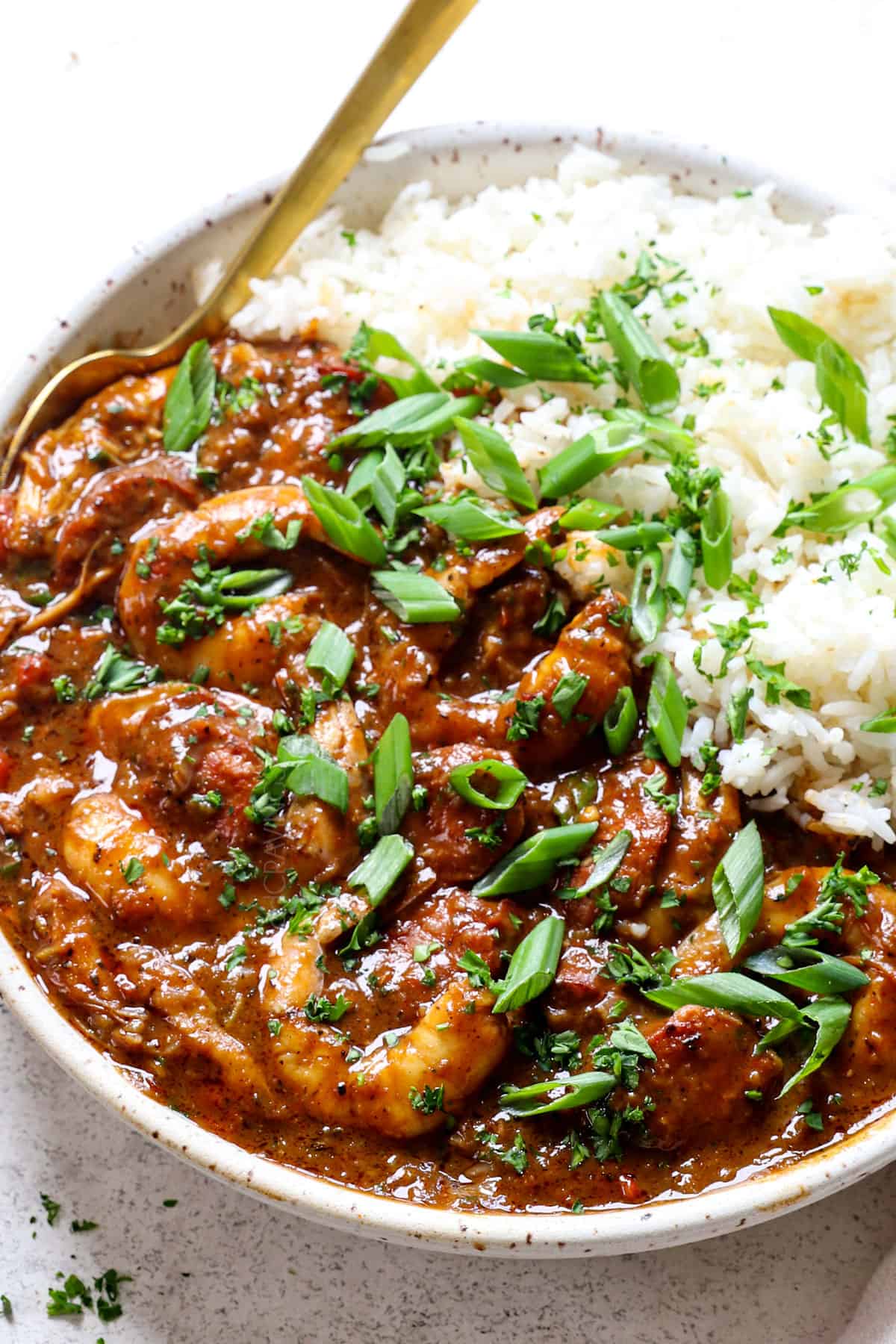
Gumbo ingredients
The list of ingredients for this chicken and sausage gumbo recipe may look lengthy, but please don’t let that scare you away! It’s actually very easy to make, with practically zero chopping – most of the ingredients are simply dumped in to the pot to simmer! Here’s an overview of what you’ll need to make this recipe from scratch (full recipe in the printable recipe card at the bottom of the post):
FOR THE protein:
For the gumbo:
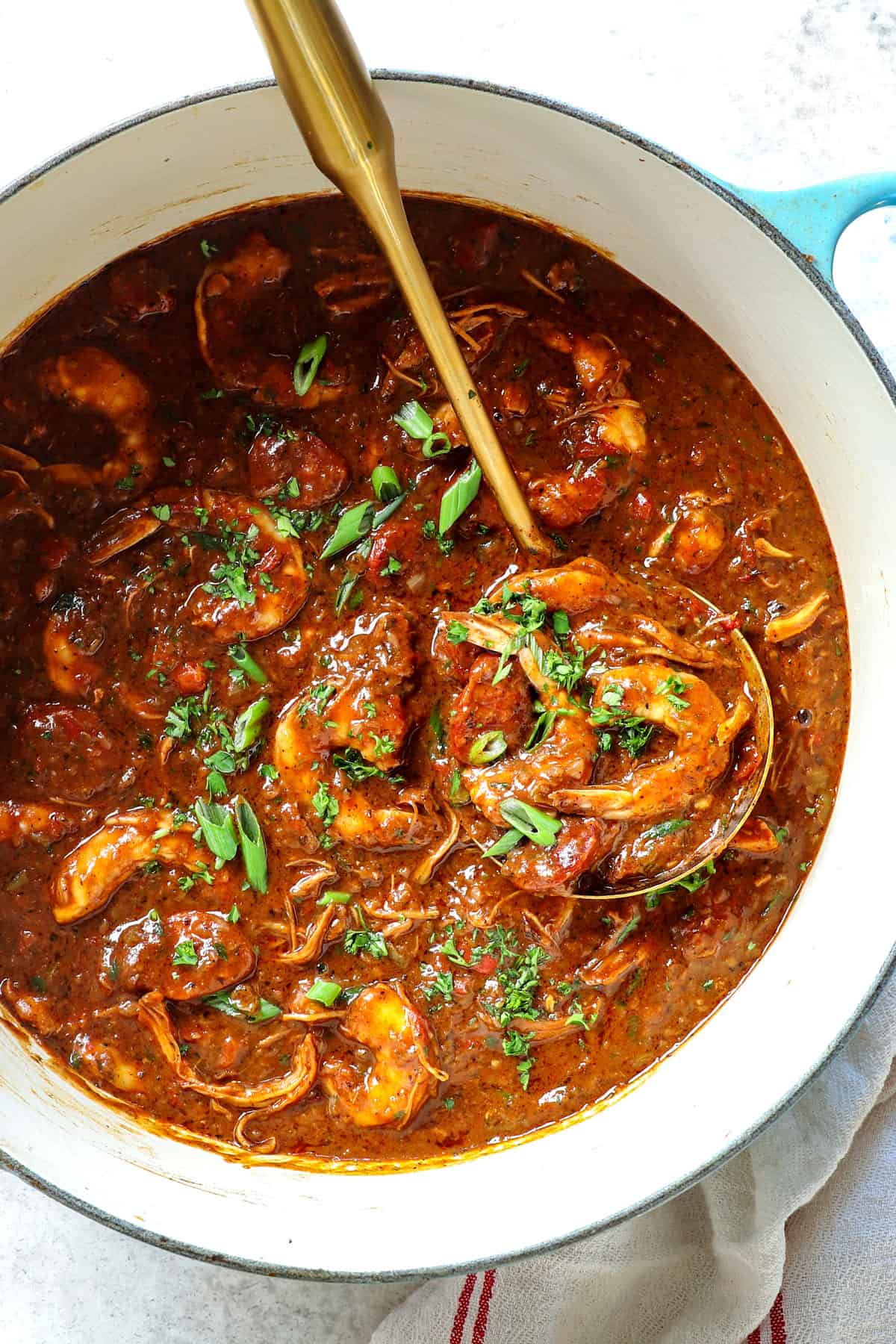

The key to this recipe is the Roux!
The term “roux” may sound fancy because it’s French (a shortening of beurre roux, which in French translates as “brown butter,”) but is very easy to make! Roux is made by cooking equal parts flour and a fat together (lard, butter, or oil); in order to thicken sauces, soups and stews.
Roux can be cooked to varying shades of doneness ranging from white, blond, or brown. For this gumbo recipe, we want a dark chocolate color (don’t stop at milk chocolate!), because the darker the roux, the deeper the bigger, bolder, nuttier the flavor. This roux is also extra flavorful and quicker to achieve thanks to the golden drippings left behind by the seared chicken and sausage.
How does it work? The sugars in the flour react with the proteins in the oil when heated, causing a Maillard reaction, or brown molecules which are flavor gold. When the broth is added, the tasty starches expand and absorb the broth creating a smooth sauce. This forms the base of this gumbo recipe AKA the best gumbo you’ve ever had!
HOW TO MAKE Gumbo
Making gumbo at home is easier than you might think, it’s essentially a one-pot stew after all! Grab a large pot and let’s get cooking with these step by step photos (full recipe in the printable recipe card at the bottom of the post):
Step 1: Chop the vegetables
You are going to love the shortcut of chopping the holy trinity of veggies in your food processor, it literally takes seconds! If you don’t have a food processor, chop by hand.

Step 2: Sear the chicken
To build the flavor of the gumbo, start by seasoning the chicken thighs with salt and pepper on each side. Sear in sizzling oil in a large Dutch oven until golden on each side, about 3 minutes. Don’t try and flip the chicken if it is sticking, it will naturally release once it’s seared.

Step 3: Cook the Sausage
To drippings, heat another drizzle of oil. Add the sausage and sear each side until browned for yet another layer of flavor. Remove the sausage to a paper-towel lined plate.
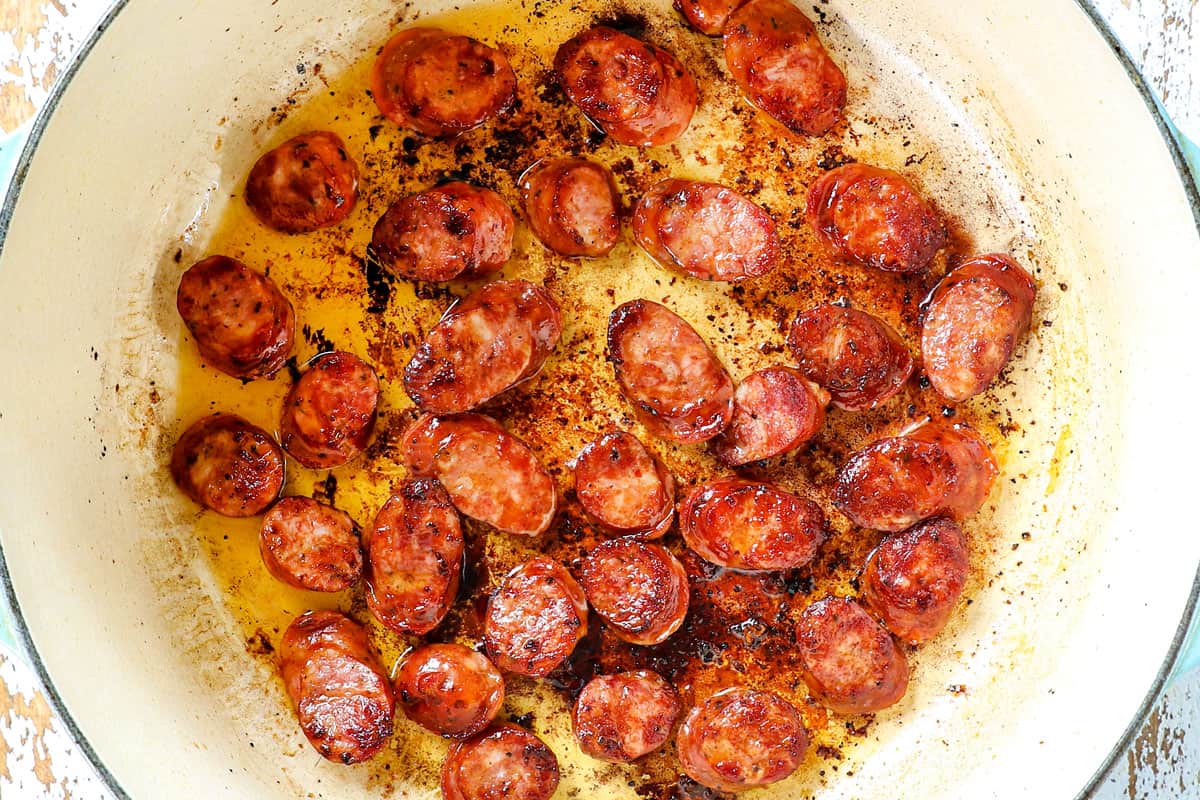
Step 4: Thicken the Gumbo with a roux
Roux is the thickening agent in this recipe which also contributes complex, deep, rich toasted nutty flavor. To make, add additional oil to the robust chicken and sausage drippings, followed by the flour and cook for about 20, whisking constantly, until the roux develops a rich dark brown color. The roux browns more quickly than seafood gumbo recipes due to the delicious chicken and sausage drippings.
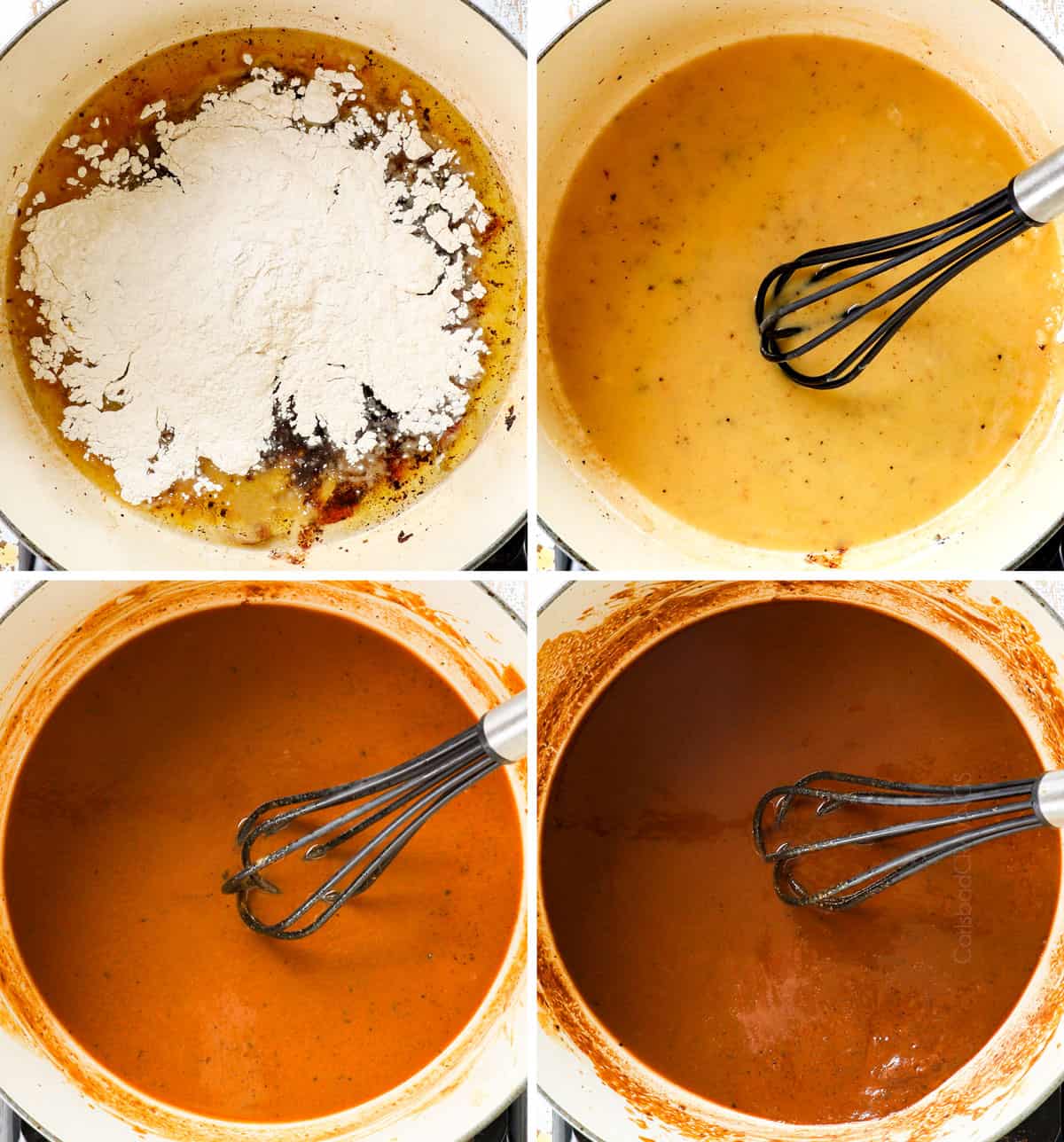
Step 5: Add a Holy Trinity of Vegetables
The Creole and Cajun holy trinity of vegetables adds aromatic sweetness to the nutty, earthy dish as the vegetables are sautéed, releasing their sugars. Sauté the chopped vegetables until tender, about 5 minutes, in the roux. The recipe won’t look that appetizing at this point, but I promise it’s the start of greatness!
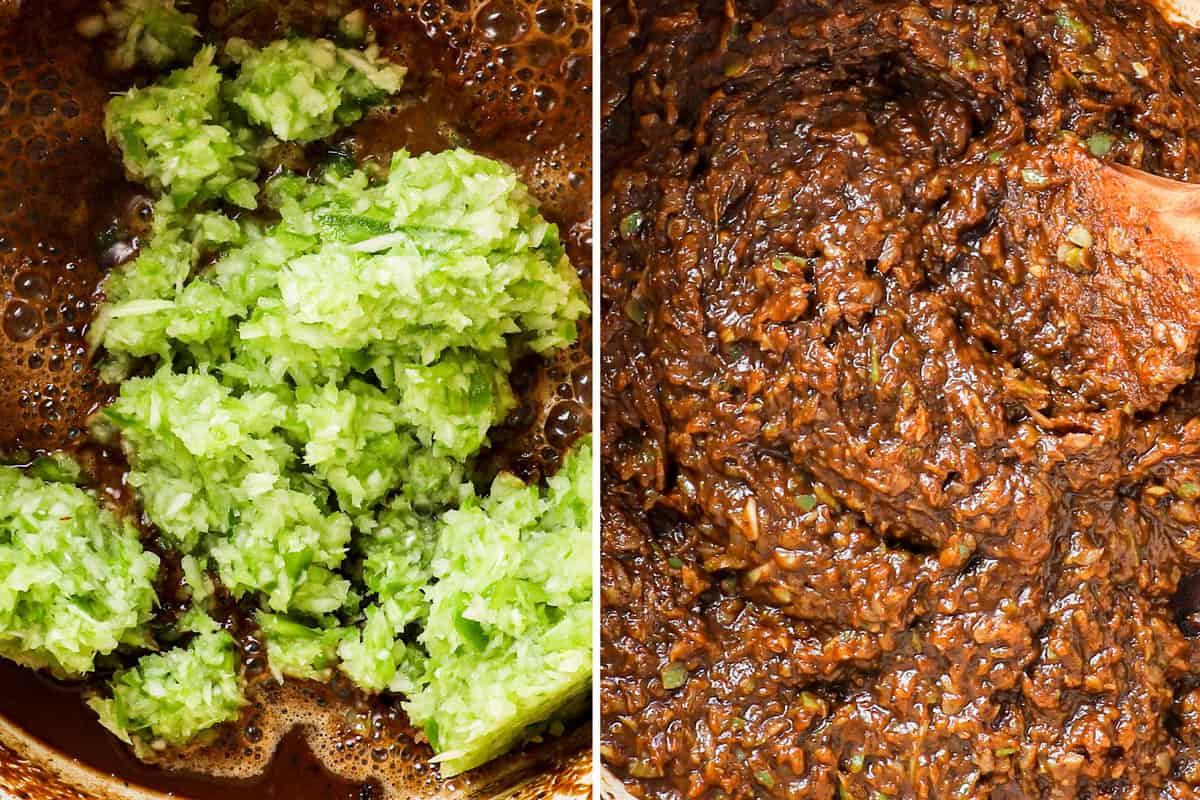
Step 6: Simmer To cook Chicken
The gumbo will simmer three separate times: first, to cook the chicken. Add the seared chicken, tomatoes (if using), chicken bouillon, and all seasonings. Simmer until the the chicken is tender, then remove it to a cutting board to shred.
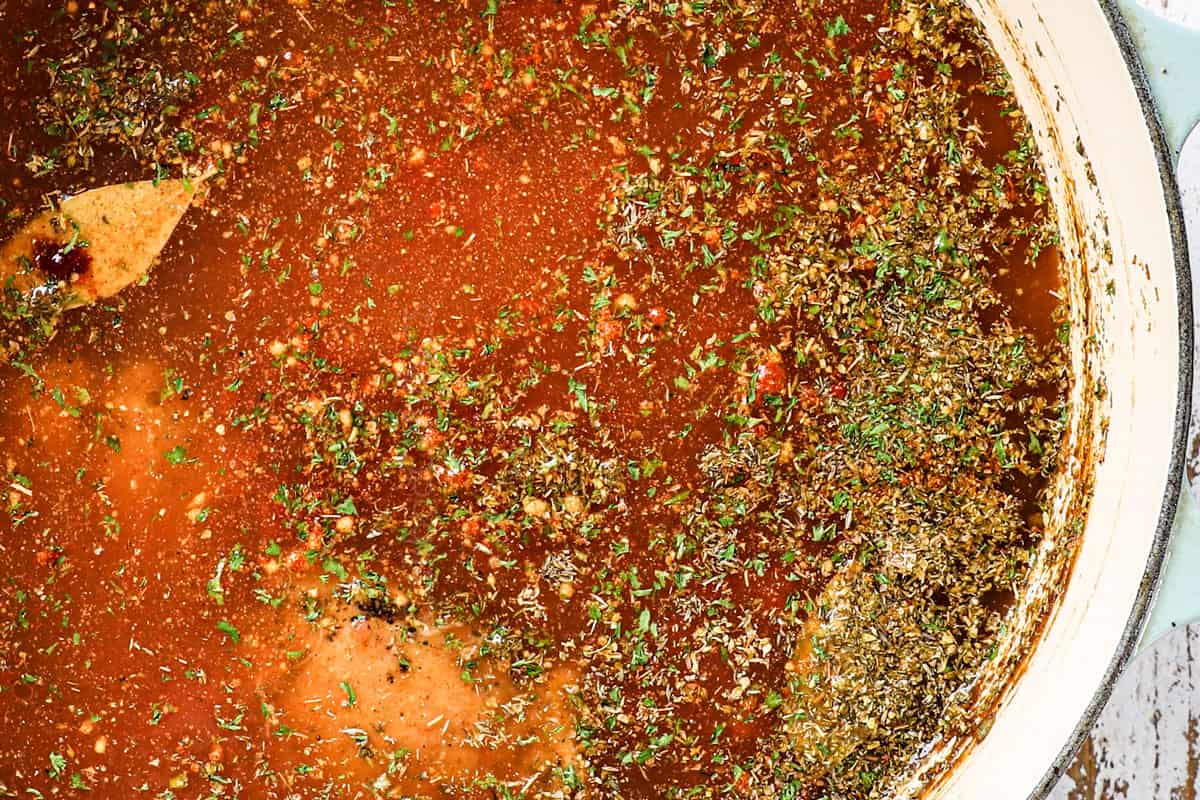
Step 7: Simmer to Thicken the Gumbo
The second simmer is to thicken the gumbo and concentrate the flavors. As the chicken cools and you work on shredding it, continue simmering the gumbo for another 20 minutes without the lid. It should thicken up beautifully during this time as moisture evaporates.
Step 8: Simmer with chicken and sausage
For the third simmer, the shredded chicken and sausage are added back to the pot. If you would like a thicker gumbo, simmer uncovered, or to maintain the current consistency, simmer covered for about 15 minutes. This brief simmer infuses the chicken and sausage with flavor without drying out the proteins and marries all of the flavors together.
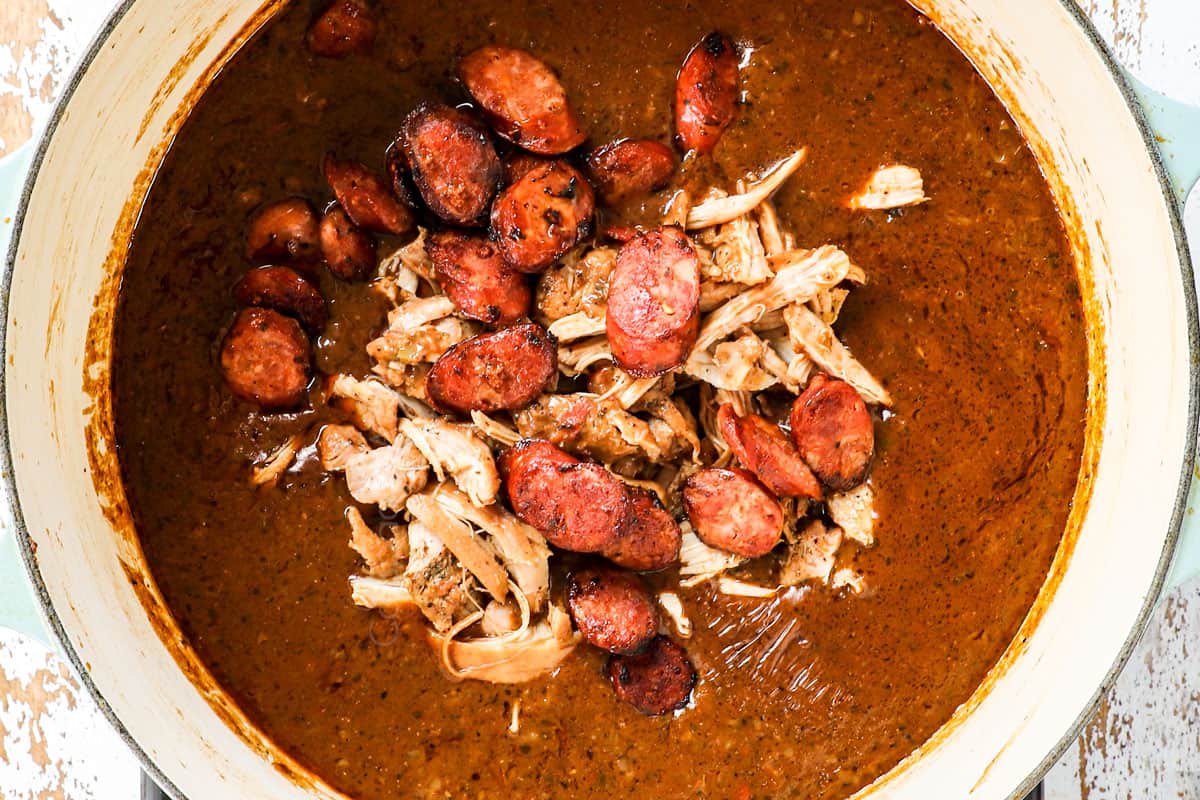
step 9: Add the gumbo filé and shrimp
Remove the pot from the heat and stir in the shrimp, Add the gumbo filé powder, green onions, and chopped parsley. Let the pot stand, covered, for 20 minutes. The residual heat will perfectly cook the shrimp while the filé will both season and thicken the gumbo.
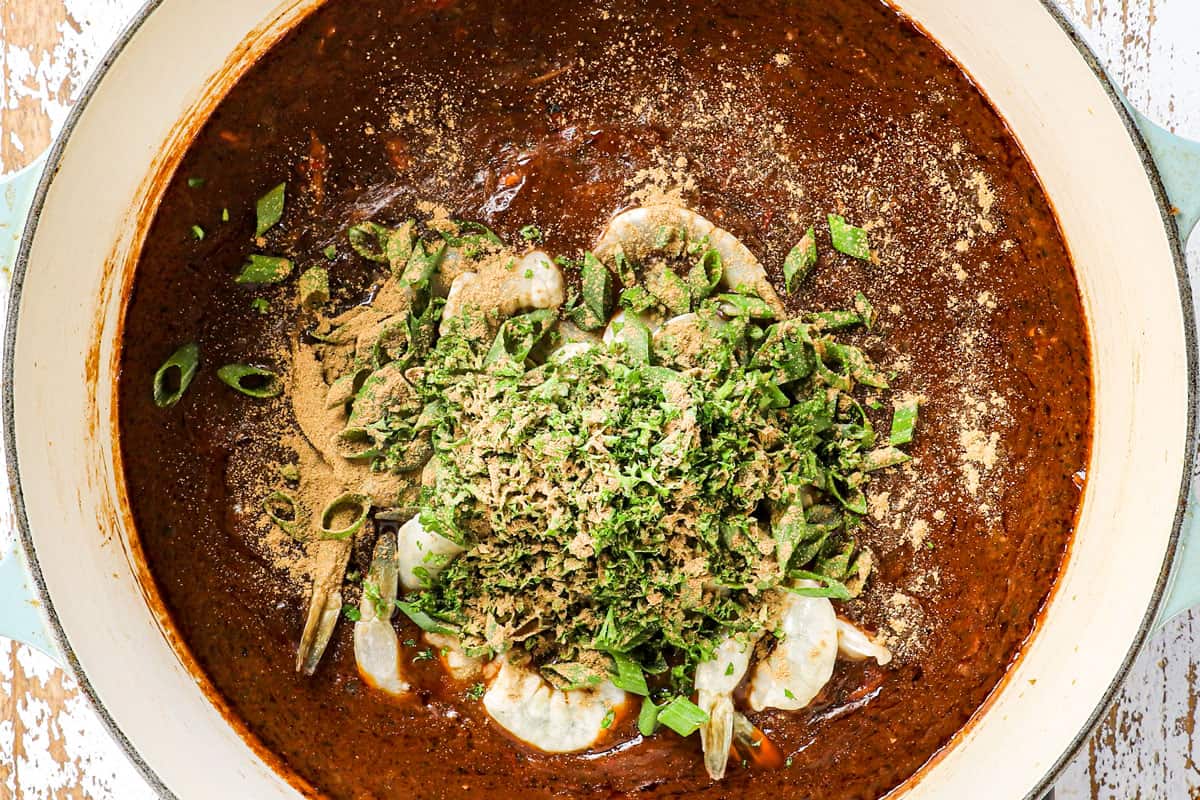

do I leave the shrimp tails on for gumbo?
Cooking the shrimp with the tails on is akin to cooking meat with the bone – it adds loads of flavor to the stew. However, I realize it can be awkward to remove the tails afterwards (kitchen shears is the easiest to do in bulk), so it’s up to you!
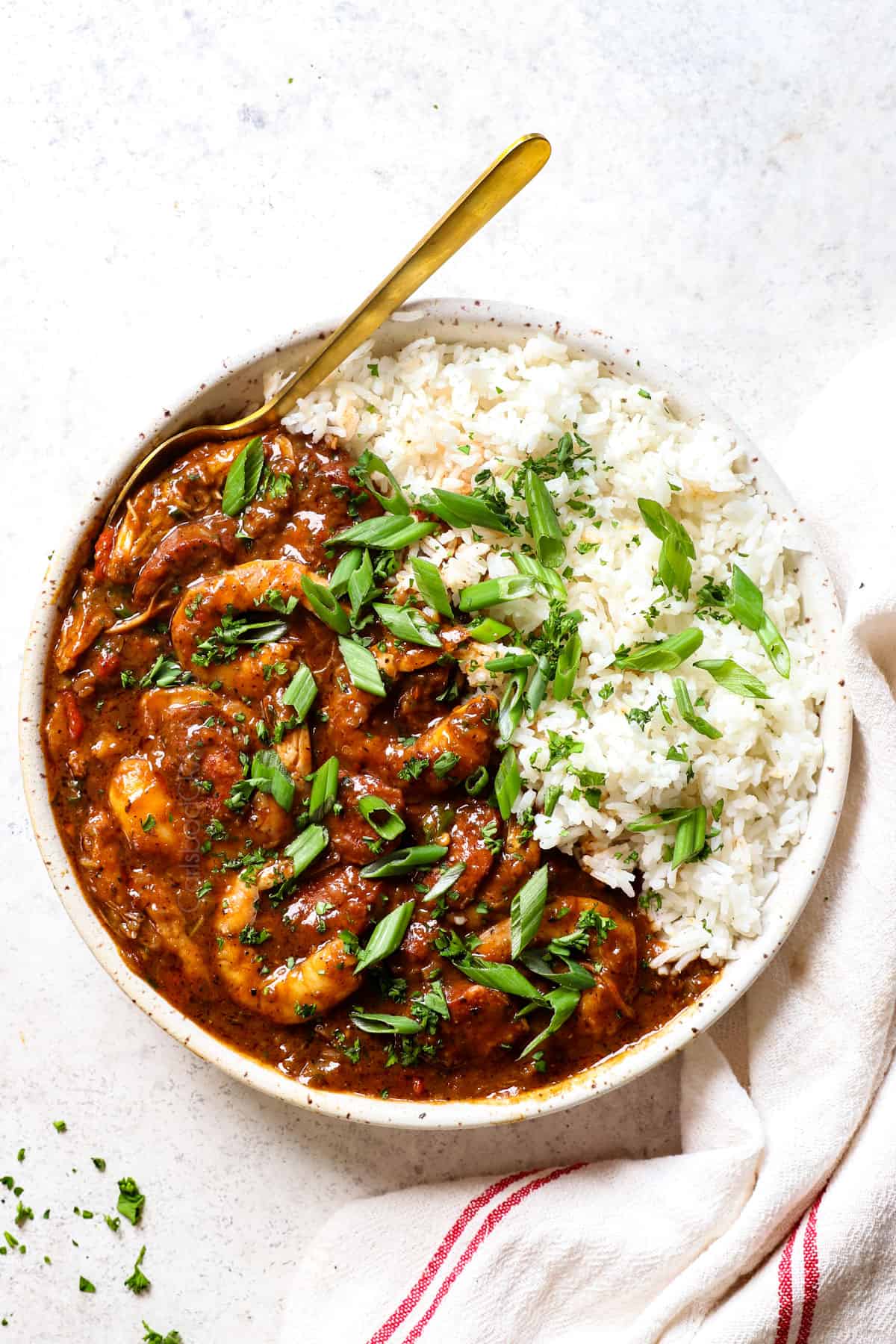
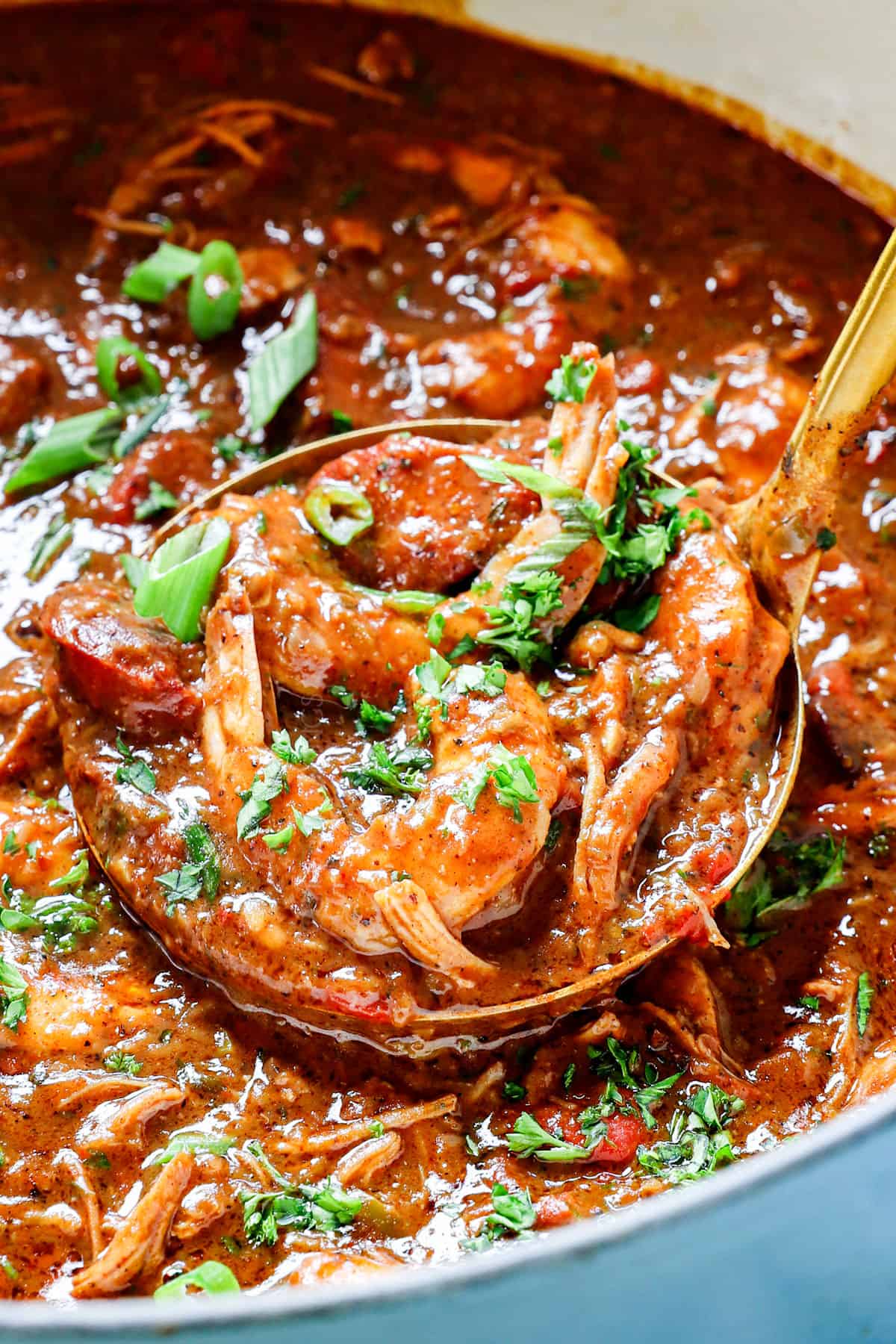

how do I prep gumbo ahead of time?
You can prepare the entire chicken and sausage gumbo recipe as written and reheat leftovers throughout the week, or you can prepare elements of the recipe in advance, or up to any stage of the recipe:
-Aromatics: the veggies can be chopped and stored in an airtight container for up to 3 days in the fridge.
-Spices: can be measured and stored in a sealable plastic bag until ready to use.
-Chicken: can be trimmed OR trimmed, seasoned and stored in a single layer in an airtight container in the refrigerator for up to two days. You can also proceed to sear the chicken, storing the pan and drippings in the fridge.
-Sausage: can be sliced and stored in an airtight container for two days, or proceed to sear after the chicken, storing the pan and drippings in the fridge.
-Roux: can be made completely ahead of time, then add the broth, (so the roux doesn’t continue to cook), seasonings and chicken back to the pot, cool to room temperature and refrigerate.
-Simmer: You can also prepare the gumbo up to the point before you add the shrimp, and then chill and refrigerate for a day or two. Bring to a simmer, remove from heat, then proceed to add the shrimp, file, green onions and parsley.
-Rice: Can be cooked up to three days in advance. Store in the fridge in an airtight container.

HOW long is gumbo good for?
Store leftover chicken, sausage and shrimp gumbo in an airtight container in the fridge for up to four days.

How do I reheat gumbo?
-Stove: Reheat large batches on the stove over medium low heat, stirring occasionally – about 5-8 minutes.
-Microwave: Transfer individual servings to a microwave-safe dish, and microwave for 2 minutes, stir, then continue to microwave for 15-second intervals, as needed.
can you freeze gumbo?
Yes, you can freeze chicken, sausage and shrimp gumbo for up to 3 months. Cool the stew completely before freezing, then store in freezer safe containers or quart size bags, or freezer bags, leaving about an inch at the top for expansion. To easily fill these bags, place them in a container that you can wrap the top around the edge of – for example, place a sandwich size bag in a mug then cuff the edges around the mug. Final packaging tip, make sure to let out any excess air before you seal.
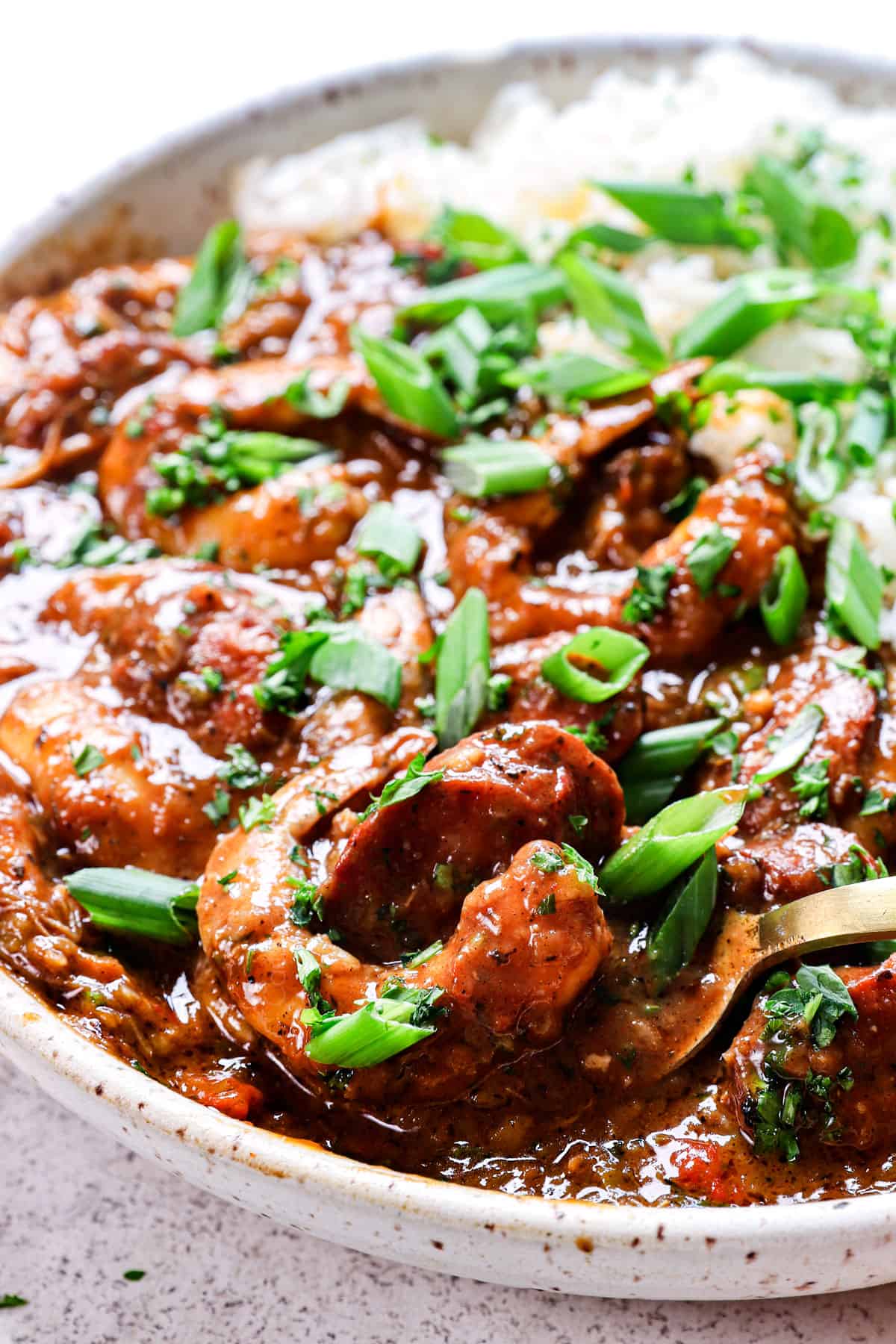
WANT TO TRY THIS gumbo RECIPE?
PIN IT to your recipe BOARD TO SAVE FOR LATER!
FIND ME ON PINTEREST FOR MORE GREAT RECIPES! I AM ALWAYS PINNING :)!
©Carlsbad Cravings by CarlsbadCravings.com
Tools Used in This Recipe
See Favorite Tools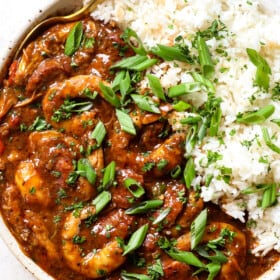
Chicken and Sausage Gumbo
Save This Recipe To Your Recipe Box
You can now create an account on our site and save your favorite recipes all in one place!
Ingredients
- 1 large yellow onion, peeled and quartered
- 4 stalks celery, chopped into thirds (to fit food processor)
- 1 large green bell pepper, seeded, roughly chopped (to fit food processor)
- 4 cloves garlic, peeled
- 3 tablespoons olive oil, divided
- 1 pound boneless, skinless chicken thighs (increase to 1 ½ lbs if not using shrimp)
- 12 ounces andouille sausage, sliced ½-inch thick (increase to 18 ounces if not using shrimp)
- 3/4 cup neutral high smoke point oil (peanut, sunflower, canola, or vegetable, etc.)
- 1 cup flour
- 1 15 oz. can fire roasted diced tomatoes with juices recommend if adding shrimp for Creole style, (I KNOW tomatoes are not in Cajun Gumbo)
- 1 tablespoon chicken bouillon (base, powder, or 3 crushed cubes)
- 1 ½ tsps EACH dried parsley, dried thyme, dried oregano
- 1 tsp EACH smoked paprika, regular paprika, onion powder, garlic powder
- ½ -1 teaspoon cayenne pepper (start with less and add more to taste)
- 2 bay leaves
- 6 cups reduced sodium chicken broth
Add Last
- 1 pound raw medium, peeled and deveined shrimp (optional)
- 1 teaspoon gumbo filé powder <<click for Amazon
- 1/2 cup chopped green onions
- 1/4 cup minced fresh parsley
For serving
- white rice for serving
- diced green onions for garnish
- Louisiana hot sauce for serving
Instructions
- Chop veggies: Place onion, celery, green bell pepper, and garlic into the bowl of a food processor; pulse until all vegetables are very finely chopped (or chop by hand).
- Sear the chicken: Pat chicken dry with paper towels. Season chicken with 1 teaspoon salt and 1 teaspoon pepper. Heat 2 tablespoons olive oil over medium-high heat in a large Dutch oven/soup pot. Once hot, add the chicken and sear until golden, about 2 minutes per side. Remove chicken to a plate but leave the drippings.
- Cook the sausage. Heat 1 tablespoon olive oil over medium-high heat (medium if your stove runs hot) in the chicken drippings. Add the sliced andouille sausage in a single layer. Sear each side until deeply golden. Using a slotted spoon, transfer to a paper towel lined plate to drain; set aside.
- Make the roux: Reduce heat to low. To the same pot, don’t wipe out, add ¾ cup neutral oil. Add the flour and whisk until combined. Increase heat to medium. Continue to cook, whisking constantly, until the roux is a rich dark brown color, like dark chocolate, about 20 minutes. I suggest turning the heat down to medium-low once you hit the chocolate brown stage then continuing to cook until dark brown. If the flour begins to stick at any point, reduce heat/and or add additional oil – you don't want it to burn!
- Sauté the vegetables: Stir in the chopped vegetables and cook over medium heat for about 5-7 minutes, until the onions are tender.
- Cook chicken: Add the seared chicken back to the pot followed by tomatoes, chicken bouillon, all spices, bay leaves and chicken broth. Partially cover, leaving a 1-inch gap opening and bring to a boil, then reduce to a simmer over medium-low until the chicken shreds easily with two forks, about 15 minutes.
- Shred the chicken: Remove the chicken to a cutting board and shred when cool enough to handle. Meanwhile…
- Simmer again: Reduce the heat to medium-low and gently simmer, UNCOVERED, for an additional 20 minutes, stirring occasionally.
- Add chicken and sausage: Add the shredded chicken back to the pot along with the seared sausage. Cover and simmer an additional 15 minutes OR simmer uncovered if you would like the gumbo even thicker. (You can also start simmering uncovered, then cover when it reaches desired consistency.)
- Add shrimp. Turn OFF the heat and stir in the shrimp (if using) gumbo filé powder, green onions, and chopped parsley. Stir well, cover, and rest for 20 minutes.
- Adjust to taste. Remove the bay leaves and season with salt (I add ½ teaspoon), pepper and or/cayenne pepper to taste. The gumbo should be thick but you can thin it with additional chicken broth if desired.
Video

Did You Make This Recipe?
Tag @CarlsbadCravings and Use #CarlsbadCravngs
Leave a Review, I Always Love Hearing From You!




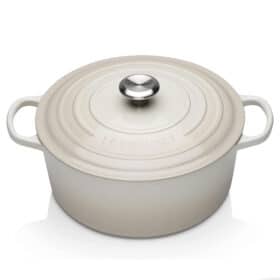
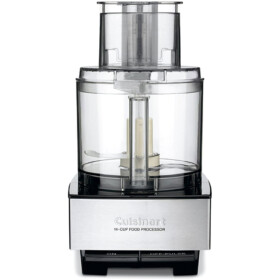

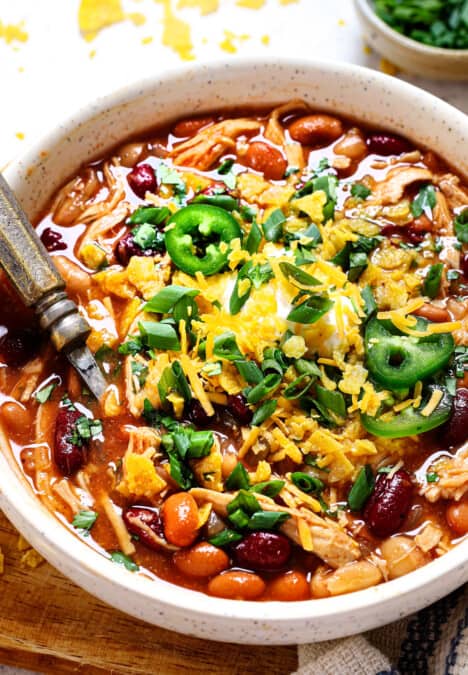

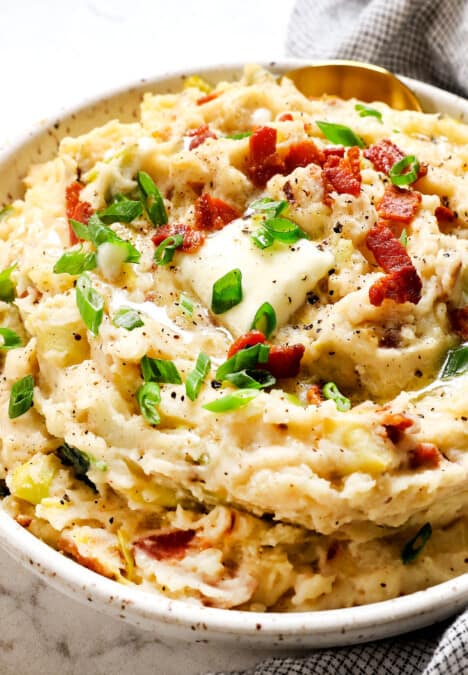
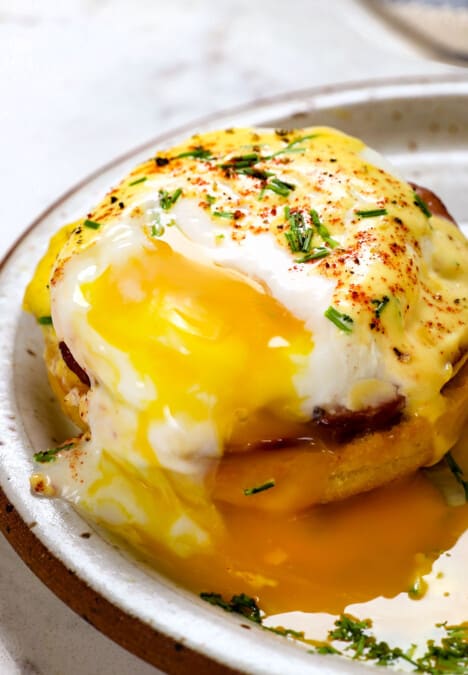

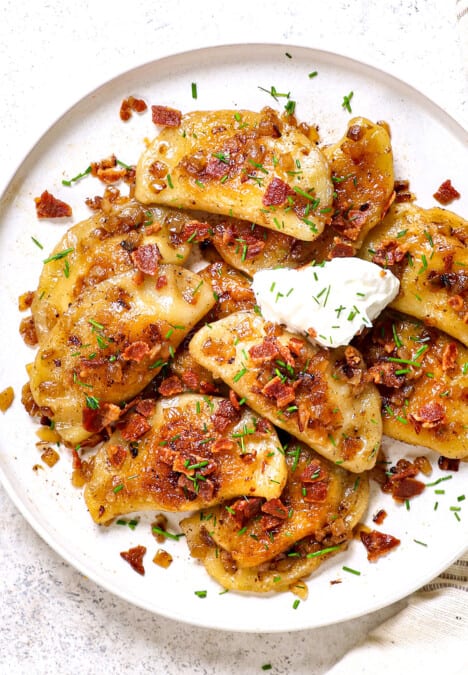























Jennifer Fulk says
This looks great! Where is the okra though? If we want to add it, should we add it at the end with the file powder? Can’t wait to try this! I have never made a true gumbo with a roux before!
Jen says
Hi Jennifer, gumbo is either thickened with file or okra, but not both. If you wanted to add it, skip the file and add it with the shredded chicken and shrimp for the last 15 minute simmer. Enjoy!
Dianne says
We’ve been making gumbo for years here in the South and learned to make the roux without the added
3/4 c. oil. It tastes the same, but is less oily. It’s healthier, too.
Toast the flour in the oven (carefully) and add to the gumbo (without the added oil). No more standing and stirring for 20 minutes. The toasted flour makes the roux a beautiful dark brown. I toast enough flour for several batches, then divide into 1 c. measurements and freeze for quicker cooking.
Jen says
Thanks for the tip Dianne!
Toni says
It was delicious! I especially loved the texture of the gumbo, very silky.
Jen says
Thanks Toni, I love hearing it was a hit!
Linda C says
I never had gumbo before so when I saw your recipe thought I’d give it a try. Delicious! And the fact that I can freeze it is an added bonus. Thank you
Jen says
I’m so glad you tried it and loved it! Thanks Linda!
Lou says
when does the 6 cups of chicken broth get added?
Jen says
Hi Lou! It gets added in step 6 with the chicken, tomatoes and spices. Enjoy!
Margaret says
Made this tonight. It was so delicious. This will be my go to recipe. Loved had the recipe was done step by step followed it to a T came out perfect.
Jen says
Thank you! I’m so glad that this will be a repeat!
Jan says
This gumbo is phenomenal! Love how you build flavors with the proteins and the spices are spot on. I did add 1/2 teaspoon of the cayenne. I had baked a chicken a day or two before but saved about two Tbsp. of drippings to add for cooking the sausage along with the oil. I stirred the roux for thirty minutes and it never got that chocolate color, maybe a light milk chocolate. Probably because I didn’t actually sear the chicken. It wasn’t real thick but it still tasted amazing. Thank you Carlsbad Cravings, I like your style! Happy New Year
Jen says
Thanks Jan! I’m so thrilled you loved it! Hope your year is going well!